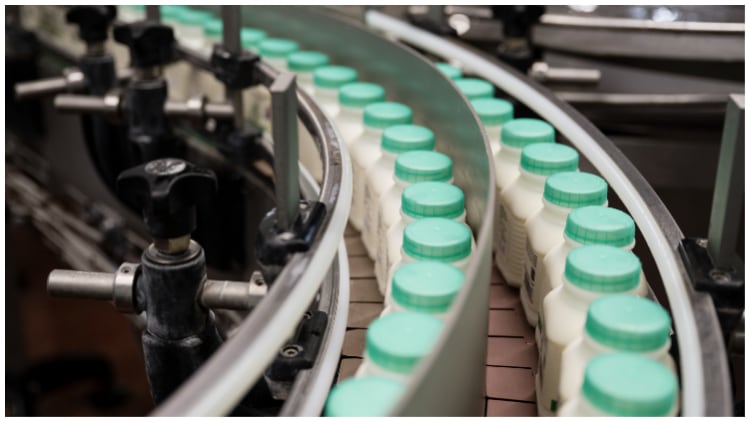How much plastic do we use vs. recycle?
Plastic production on a global scale has risen substantially, increasing from virtually zero to some 400 million tonnes per annum today.1,2
Although plastic can be recycled (to some extent, depending on economic and logistical factors) just 9% actually is, while 12% is incinerated with the rest ending up on landfills or elsewhere in the environment.1
According to WRAP, plastic production, use and disposal contributes to approximately 1.8 billion tonnes of carbon emissions every year. In the UK, plastic packaging specifically accounts for almost 70% of our plastic waste.
Britain has had success with HDPE (milk containers) and PET bottles, with up to 75% recycled, but in the grand scheme of things, as Charles Baughan, owner of Westaway Sausages – which prides itself on its plastic-free packaging – told our editor, less than 10% of plastic is recycled overall.
“In the UK we use around one million tonnes of plastic every year to pack and distribute our food,” he added. This is because it offers a hygienic, safe and easy solution for the food and drink sector.
The health implications of plastic pollution
But there is clear evidence of the damage plastic pollution is having on our ecosystems and environment. The impact of microplastics in food is also raising a few eyebrows, with some reports suggesting it could be harmful to humans.
“A wealth of scientific studies has demonstrated that people inhale, ingest and absorb microplastics in their daily life,” stated Maria Westerbos, founder of the Plastic Soup Foundation & Plastic Health Summit. “Human exposure to microplastics can adversely affect the metabolism of humans and induce severe illness, with one 2022 study highlighting that micro- and nanoplastics negatively affect pregnancies and the developing foetus.”3
Westerbos also pointed to a recent study from the Vrije University in Amsterdam which found that of the samples it tested (dairy, meat and blood of livestock), 80% contained microplastics.
“We urgently need to rid the world of plastic in animal feed to protect the health of livestock and humans,” she continued.
However, Martin Kersch, executive director of Food Service Packaging Association, contends that the biggest contributors of microplastics extend beyond the packaging sector, with synthetic textiles, car tyres and cigarette waste being key contributors.
“Plastic packaging accounts for a tiny part of microplastics. The government legislated to prevent the use of microplastic in hygiene and cleaning applications. A large number of personal care producers had already removed microplastics from their products many years before the legislation [Plastic Packaging Tax] came in to being.
“The issue is the government targets packaging a small contributor but ignores the big contributors because the public do not want to change their lifestyles or pay substantially more to avoid microplastics. Next time you see someone dropping a cigarette end into a drain, stop them.”
The challenges of making changes
The reason we have been so reliant on plastic is a result of the benefits it boasts, as mentioned before it's a safe way to store food and allows for produce to remain fresher for longer. In fact, according to the British Plastics Federation, advanced plastic packaging extends the life of a steak up to 10 days and by 14 days for a cucumber. Moreover, its website points to the statistic of of the environmental burden food waste has compared to packaging waste, with the former being at least ten times more damaging, even before taking into account the impact of methane from decayed food.4
“Plastic is lightweight and flexible and allows for utilisation in a wide array of production and packing processes both cost effectively and efficiently, minimising food mile costs, incidental damage, and waste by promoting hygiene and extending shelf-life,” said Emma Verkaik, Membership & Marketing Director at BCMPA.
However, some alternatives, and indeed recyclable plastics, do not always possess the same abilities as their non-recyclable counterparts.
“The plastic debate is an everyday part of the packaging industry,” she continued. “Although often demonised, the use of plastic in a host of contract manufacturing, packing and fulfilment sectors remains significant, as it provides benefits and advantages over many alternative materials and reduces wastage, particularly in the food sector.
“The Plastic Packaging Tax which came into being last year was developed to encourage the use of recycled content,” commented Kersch. “An issue for food producers is, in order to comply with food safety regulations, recycled plastic content is limited to packaging made from PET and HDPE.
“PET is not suitable for all applications, most notably microwaving, especially at high settings.”

According to Verkaik, “the use of single use plastics by the packaging industry is being quickly disposed of and replaced by recycled counterparts”.
But Westerbos is less convinced: “The problem with recycling plastic is that it doesn’t really happen. It can’t be used to make the same products again; for example, food packaging that is recycled cannot be used again as food packaging.”
She referenced a report from Minderoo5 which claims recycling is failing to scale at a sufficient pace. “We need to stop thinking that this problem can be solved through recycling plastic.”
Moreover, although Verkaik states that we’re witnessing the proportion of recycled plastics rising, which has seen a drop in commercial plastics’ carbon footprint, she also said the huge demand for recycled product has resulted in higher prices and a lack of material availability.
This is an issue which Kersch also raised: “Recycled plastic is in huge demand globally and more often than not is more expensive to purchase than virgin plastic material.”
This block “will no doubt be softened over time as the collection methods become more reliable”, Verkaik suggested.
“The UK government’s recycling waste consistency legislation will improve the quality of plastics going into bins and driven by Extended Producer Responsibility (EPR) we will find plastic recycling rates increasing further,” agreed Kersch. “Of course, all materials can be recycled. The key is to ensure it is separated, presented in a relatively clean condition and in sufficient quantities to make it environmentally and financially worthwhile to recycle. The ability to dispose of flexible plastics at our major supermarkets is a fantastic development as are industry initiatives to collect packaging that may not normally be disposed of in household waste bins and take them to pre-processors.”
Kersch also pointed to the challenge of packaging entering the UK which doesn’t meet food contact regulations. “Such packaging undercuts the price of fully compliant packaging by cutting corners. Responsible food producers will make sure they see evidence of packaging’s food safety along with other claims made by packaging.” For example, packaging which claims it is compostable must be certified as such.
Alternative packaging
“The food industry is addicted to plastics,” Baughan added. “In finding alternatives, we need to ensure that these materials are indeed more sustainable than plastics and still have the same or better attributes in terms of protection and shelf-life.
“Pioneering new approaches and scaling up those that are successful must be the way forward. We cannot do nothing. We need genuine innovation.”
Westaways has developed compostable packaging, replacing its PVC overwrap film. This home compostable alternative is made of PBAT (Polybutyrate Adipate Terephthalate) and although it is a plastic, it breaks down in around 57 days without leaving behind microplastics and even, according to the brand, adds nutrients to the compost.
“We have challenged convention and shown what is possible,” Baughan said.
EIT Food is also helping to drive change in this regard and has been working with several startups in the alternative packaging space.
With a recent study revealing that food waste represents half of total greenhouse gas emissions from the food system,6 Dr Andy Zynga, CEO of EIT, emphasised the importance of developing alternatives that are mindful of these numbers and which address both plastic pollution and food waste in tandem.
“The UK-based packaging startup SoluBlue, which we supported through our Seedbed Incubator Programme, has developed an organic polymer that looks and feels like clear plastic, but when composted it biodegrades within weeks and can be safely ingested by wildlife. Crucially, the packaging material directly tackles food waste by absorbing excess moisture, dramatically extending the shelf life of the food it contains.”
The industry is also seeing an uptick in fibre-based packaging, and this is an area which DS Smith is exploring.
“Fibre-based packaging is packaging that derives from plants, predominately trees, but also grass and even seaweed. Some fibres can also be sourced from a second use of various process by-products, like agricultural and food processing waste-streams. These fibres, both virgin and recycled, are used to produce pulp for packaging,” said Liz Manuvelpillai sales, marketing and innovation director – UK packaging at DS Smith.
“Last year we announced our £100m R&D and innovation package to accelerate our work in the circular economy. This includes exploring how alternative fibres, like seaweed, can be used as a raw material in paper and packaging products amid increasing demand for sustainable goods from customers and consumers alike.”
Beyond the fibres and product innovations, DS Smith has also created its own ‘circular design metrics’, which helps its customers assess the circularity and sustainability of their packaging, including the recycled and recyclable contents of their packaging.
Sustainability claims on packaging
Kersch also flags claims on packaging as a potential downfall and something which must be looked at carefully.
“The Competition and Markets’ Authority Green Claims Code is a force for good and we hope will bring an end to generalised ‘green’ and ‘sustainability’ claims that have no universally-recognised and certified meaning nor substantiation. We urge your readers to examine each claim and demand the lab testing and certifications to support them.
He concluded: “We must also be sure not to increase pollution by describing packaging as ‘biodegradable’, which encourages littering or by the use of oxo-degradable additives which is harmful to the environment.”
Should we ditch plastic?
It appears that we are making progress in the UK when it comes to limiting plastic pollution, with the introduction of the EPR and Plastic Packaging Tax, alongside an increase in recycling and repurposing streams provided by councils, brands and retailers. This also demonstrates that good work can be done. But as always, it's a question of whether it's enough - or indeed, fast enough, as the impacts of climate change become ever more present.
There are still many items within the supermarket which appear to be wrapped in plastic unnecessarily - such as avocados and bananas. Although plastic wrap will likely extend the shelf-life of a bunch of bananas by three days,4 is it really worth it? Is our time not better spent on re-educating consumers on the value of food, on the impact that food waste has and putting the responsibility back into the hands of where most food waste occurs (in the home)? Food waste is the bigger issue here and consumers need to be aware of the consequences of their throwaway culture. Don't get me wrong, there are certainly improvements to be made our end but educating Britain seems a pretty good place to start.
What are your thoughts? Let us know in the comments.
References
- https://www.unep.org/resources/report/drowning-plastics-marine-litter-and-plastic-waste-vital-graphics
- www.statista.com/statistics/282732/global-production-of-plastics-since-1950/
- https://ehp.niehs.nih.gov/doi/10.1289/EHP10873
- www.bpf.co.uk/packaging/why-do-we-need-plastic-packaging.aspx#:~:text=Plastic%20packaging%20allows%20food%20to,do%20not%20go%20to%20waste.
- www.minderoo.org/plastic-waste-makers-index/downloads/
- www.nature.com/articles/s43016-023-00710-3


